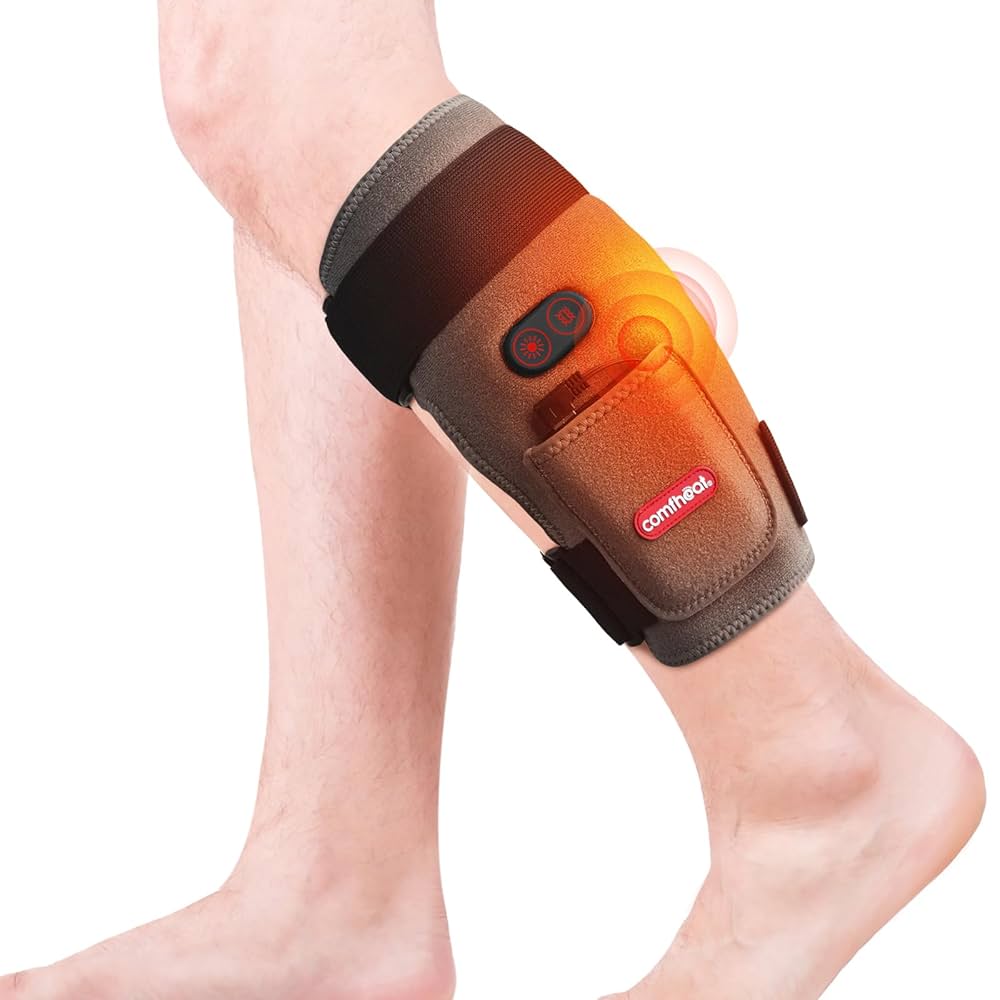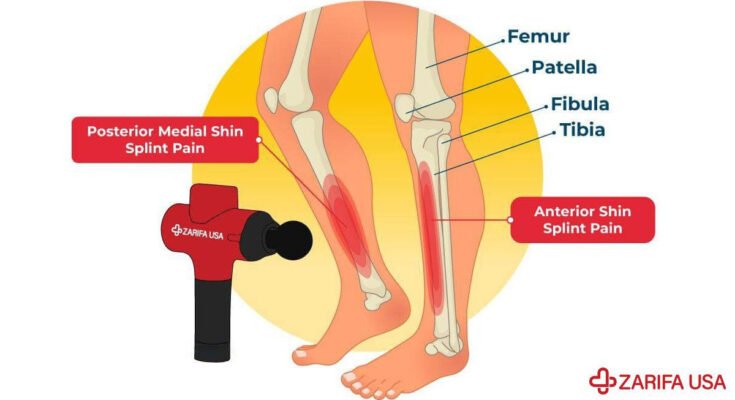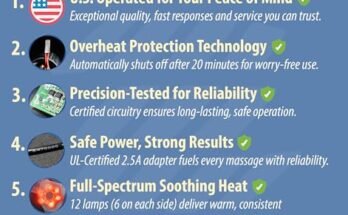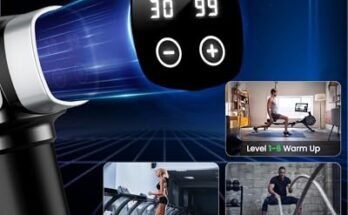If you’ve ever felt a sharp pain along your shin after a run, you might be dealing with the notorious shin splints. It’s frustrating, isn’t it?
You’re geared up for your workout, but that persistent discomfort holds you back. You want relief, and you want it fast. You’ve heard about vibration therapy as a potential solution, but does it really work? Imagine finally breaking free from the cycle of pain and getting back to the activities you love.
We’ll explore whether vibration can be the answer you’ve been searching for. Discover the truth behind this intriguing method and find out if it’s the key to easing your shin splint struggles. Dive in to learn how you can potentially reclaim your stride and say goodbye to those nagging aches.
Causes Of Shin Splints
Understanding the causes of shin splints is crucial for prevention and treatment. Shin splints, a common condition among athletes, occur due to stress on the shinbone and surrounding tissues. The pain is often felt along the inner edge of the shinbone.
Common Risk Factors
Several risk factors contribute to developing shin splints. Poor footwear is one of them. Shoes lacking proper support can strain your feet and legs. Flat feet can also increase the risk. This condition causes uneven stress distribution on the legs.
Running on hard surfaces adds extra pressure on the shinbone. Sudden changes in exercise routines can lead to shin splints too. Increasing intensity or duration rapidly strains the muscles. Weak ankles or hips may contribute as well, affecting stability and support.
Activities Leading To Shin Splints
Certain activities are known to trigger shin splints. High-impact sports like soccer or basketball are common culprits. These sports involve frequent running and jumping. Dancing, especially ballet, puts excessive pressure on the shins. Long-distance running often leads to shin splints due to repetitive impact.
Military training is another activity that can result in shin splints. Marching and running with heavy gear strains the lower legs. Aerobic exercises done on hard surfaces can also increase the risk. Understanding these activities helps in managing shin splints effectively.

Symptoms And Diagnosis
Vibration therapy may offer relief for shin splints by reducing pain and swelling. Symptoms include tenderness and aching in the lower leg. Diagnosis often involves physical examination and sometimes imaging tests to rule out fractures.
Understanding the symptoms and diagnosis of shin splints is crucial if you’re experiencing pain in your lower legs. Recognizing the signs early can make a significant difference in managing and treating this common condition among athletes and runners. While some discomfort might seem minor, knowing when it’s time to seek professional advice can prevent more serious injuries.Identifying Shin Splints
You might feel a dull ache or sharp pain along the inner edge of your shinbone. This is typically the first sign that shin splints are developing. The pain often worsens during physical activity and may decrease when you rest. Swelling in the lower leg can also indicate shin splints. You might notice tenderness or soreness when you touch the affected area. Sometimes, the pain can be so intense that it disrupts your daily routine. You may find that the pain is more pronounced in the mornings or after sitting for long periods. This stiffness can make it difficult to start moving again. Have you ever noticed a slight relief after warming up, only for the pain to return later?When To Consult A Doctor
If the pain persists or worsens over time, it’s wise to see a doctor. A professional diagnosis can confirm whether you have shin splints or another condition, such as a stress fracture. Ignoring the symptoms might lead to more severe injuries. Consult a doctor if you experience severe swelling or if the pain prevents you from walking comfortably. A delay in treatment can prolong your recovery and impact your ability to engage in physical activities. Pay attention to your body. If you feel something isn’t right, trust your instincts. Have you ever pushed through pain only to regret it later? Seeking medical advice early can save you from that mistake.Traditional Treatments
Exploring the benefits of vibration therapy for shin splints can reveal surprising advantages. Gentle vibrations might reduce pain and improve muscle recovery. Incorporating vibration treatments into traditional therapy could offer a balanced approach to healing.
Traditional treatments for shin splints have been used for years. These methods focus on reducing pain and inflammation. They aim to aid recovery and prevent further injury. Understanding these treatments can help manage shin splints effectively. Below are key treatments often recommended by healthcare professionals.Rest And Recovery
Rest is crucial for healing shin splints. Avoid activities that strain the legs. Giving muscles time to heal reduces pain. Short walks are okay, but avoid running. Elevate the legs to reduce swelling. Resting allows tissues to repair. It also prevents worsening of the injury. Sleep is vital for overall recovery. Ensure adequate rest every night.Physical Therapy Options
Physical therapy offers structured recovery plans. Therapists design exercises to strengthen the legs. Stretching exercises improve flexibility. They reduce tension in the muscles. Balance exercises can enhance stability. These exercises prevent future injuries. Therapists may use massage techniques. Massage helps to relieve muscle tightness. Ultrasound therapy may be used to reduce inflammation. Personalized therapy plans suit individual needs. Regular sessions ensure progress and prevent setbacks.Role Of Vibration Therapy
Shin splints can cause discomfort and hinder your daily activities. Many seek solutions to ease the pain and aid recovery. Vibration therapy has gained attention as a potential remedy. This therapy involves using vibrations to stimulate muscles and tissues. It is believed to enhance blood flow and reduce pain. Let’s explore how vibration therapy might help with shin splints.
How Vibration Therapy Works
Vibration therapy involves applying mechanical vibrations to the body. These vibrations target the affected area to stimulate healing. The vibrations help increase blood circulation to muscles and tissues. This boost in blood flow can aid in reducing inflammation. It may also promote faster recovery by delivering more oxygen to the area. The gentle vibrations can help relax tight muscles, providing relief from pain. Regular sessions might enhance flexibility and reduce muscle soreness.
Scientific Evidence
Studies have explored the effects of vibration therapy on muscle recovery. Some research indicates positive outcomes for reducing muscle pain. While evidence supports its benefits, more studies are needed for conclusive results. The therapy is generally considered safe for most individuals. It is important to consult a healthcare professional before starting any new treatment. They can provide guidance based on your specific condition and needs.
Benefits Of Vibration For Shin Splints
Shin splints cause discomfort and can hinder daily activities. Vibration therapy offers potential relief for this condition. Many individuals find vibration helpful in managing pain and promoting healing. Let’s explore how vibration can benefit those suffering from shin splints.
Pain Reduction
Vibration therapy can decrease the pain associated with shin splints. The gentle vibrations relax the muscles around the shin. This relaxation helps ease the tension that contributes to pain. Many users report feeling less discomfort after regular sessions. The relief can enhance your ability to move freely.
Improved Blood Circulation
Good circulation is vital for healing shin splints. Vibration therapy boosts blood flow to the affected area. Better blood circulation means nutrients and oxygen reach the muscles faster. This process aids in the recovery and reduces inflammation. Improved circulation also helps in flushing out toxins from the muscles. It supports overall muscle health and reduces the risk of future injuries.

Choosing The Right Vibration Device
Considering vibration therapy for shin splints? You’re not alone. Many athletes and fitness enthusiasts explore vibration devices for relief. Choosing the right one can make a difference in your recovery journey. Let’s delve into the types and features to consider.
Types Of Devices
There are various vibration devices available. Some are handheld, while others are platform-based. Handheld devices are portable and easy to use. They target specific areas like shins effectively. Platform devices involve standing or sitting on them. They provide overall body vibration, which may aid in recovery.
Key Features To Look For
When selecting a vibration device, consider a few key features. Adjustable intensity levels are crucial. They allow you to customize the vibration strength. This ensures comfort and effectiveness. Battery life is another important factor. A long-lasting battery means fewer interruptions during sessions.
Portability matters if you travel often. Lightweight devices are ideal for those on the go. Look for user-friendly controls. Simple interfaces make the device easy to operate. Also, check for durability. A well-built device will last longer, providing better value.
Precautions And Considerations
Exploring vibration for shin splints requires caution. Consult a doctor before trying new treatments. Start with low-intensity vibrations to avoid worsening the condition.
Vibration therapy can help with shin splints. But it is essential to take precautions. Knowing the right safety tips and understanding contraindications is vital. This ensures effective and safe treatment.Safety Tips
Begin with a gentle setting. Your body needs time to adjust. Use short sessions to prevent strain. Listen to your body. Stop if you feel pain. Maintain proper posture. This avoids unnecessary stress on your muscles. Consult a professional before starting. This ensures you use the device correctly.Contraindications
Vibration therapy is not for everyone. People with certain conditions should avoid it. Those with bone fractures must consult a doctor. Pregnant women should seek medical advice first. Those with pacemakers or implants need a doctor’s guidance. Avoid using it on open wounds or bruises. Always check with a healthcare provider if unsure. `
Combining Treatments For Best Results
Many people struggle with shin splints, and finding relief can feel like a never-ending journey. While vibration therapy shows promise, combining it with traditional treatments may offer the best outcomes. Mixing methods could be your key to faster recovery and less pain. Ever thought about how different treatments might work together for you?
Integrating Vibration With Traditional Therapies
Imagine using vibration therapy alongside ice packs or compression sleeves. Combining these can target inflammation while soothing muscle tension. Vibration could enhance blood flow, making other treatments more effective. It’s like giving your body a holistic approach to healing. Have you ever tried mixing therapies like this before?
Consider adding vibration therapy during your stretching routine. It might help ease tight muscles, allowing for deeper stretches. Pair this with massage therapy to tackle sore spots more thoroughly. Each treatment complements the other, potentially speeding up recovery.
Personalized Treatment Plans
Not everyone responds to treatments the same way. Your body might need a unique blend of therapies. Talk to your healthcare provider about creating a personalized plan. They can help you decide which treatments to combine based on your specific needs.
Listening to your body is crucial. Pay attention to how each therapy affects you. Adjust your plan based on what feels best. Some might benefit from vibration therapy after exercise, while others might need it before. Experiment to find what works for you.
Ever thought of keeping a treatment journal? Track your therapies and how you feel after each session. This can help you and your healthcare provider refine your plan. What combination has provided the most relief for you?
Frequently Asked Questions
Can Vibration Therapy Relieve Shin Splints?
Vibration therapy may help reduce pain and inflammation associated with shin splints. It improves blood circulation and promotes healing. Consult a healthcare professional before trying vibration therapy for shin splints.
How Effective Is Vibration For Shin Splints?
Vibration can be effective for temporary relief from shin splints. It enhances blood flow and reduces muscle tension. However, it should be combined with other treatments like rest and stretching for optimal results.
Does Vibration Reduce Shin Splint Recovery Time?
Vibration might help in speeding up recovery from shin splints. It promotes circulation and reduces stiffness. Combining vibration with rest and proper exercises can enhance recovery.
Is Vibration Therapy Safe For Shin Splints?
Vibration therapy is generally safe for shin splints, but consult a healthcare provider first. It may not be suitable for everyone, especially those with certain medical conditions.
Conclusion
Vibration therapy can aid in easing shin splints. It’s not a miracle cure but can help reduce pain. Consistent use may improve comfort and speed up recovery. Always consult a healthcare professional before starting new treatments. Listen to your body and adjust routines as needed.
Combining vibration with rest and proper footwear can enhance benefits. Everyone’s body responds differently, so patience is key. Exploring various methods ensures the best results for your unique needs. Remember, it’s important to stay informed and proactive in managing shin splints effectively.



